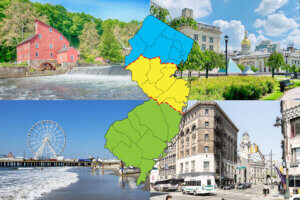The Jersey Shore is rightfully touted as one of the state’s greatest features, and nearly 2-in-3 Garden State residents will spend some time there this summer. However, the Monmouth University/New Jersey Monthly Poll also found that few residents will make the shore their family’s primary vacation for the year and many say the frequency of their shore trips has fallen off since childhood.
Fully 6-in-10 state residents (60%) say they will visit the Jersey Shore this summer, while another 5% live down the shore year round. However, about 3-in-10 residents (31%) have no plans to stick their toes in the Jersey sand this year. Senior citizens (41%) and those who earn below $50,000 (38%) are among those most likely to say they will avoid the ocean breezes.
In fact, the poll finds that most New Jerseyans report a decline in their shore visits over the years. Nearly half (46%) say that they spend less time down the shore now than they did as a child. This compares to 20% who spend more time down the shore as an adult and 21% who visit the shore with the same frequency they did as a child. Another 11% of New Jersey adults report never visiting the shore as a child. North Jersey residents (52%) are somewhat more likely than those closer to the coast in the state’s central (42%) and southern (40%) regions to report a decline in their shore visits since childhood.
Turning to this coming summer, nearly 1-in-4 New Jerseyans (23%) say they plan an extended shore stay of a week or longer. Residents earning over $100,000 a year (31%) are most likely to be planning at least a week down the shore. Among those who will spend at least a week down the shore, just over half (54%) say that this will be their family’s main vacation trip for the year.
“Given the ever increasing rental rates for a shore house, it’s perhaps not surprising that many Jersey Shore vacationers tend toward the wealthier end of the spectrum. However, a number of lower income families still see the shore as a summer destination,” commented Patrick Murray, director of the Monmouth University Polling Institute.
The poll also found that shore vacationers are creatures of habit. Among those who will spend at least a week on Jersey sands, 24% own a second home down the shore and another 52% rent in the same town year after year. Only 20% of shore vacationers report shopping around in different towns each year for a place to rent.
This poll was conducted by the Monmouth University Polling Institute by telephone with 804 New Jersey adults from April 12-16, 2007. This sample has a margin of error of ± 3.5 percent. These poll results are featured in the June 2007 issue of New Jersey Monthly magazine.
DATA TABLES
The questions referred to in this release are as follows:
(* Some columns may not add to 100% due to rounding.)
1. Will you visit the Jersey shore this summer? If YES, will you stay for a week or longer?
| TOTAL | AGE | INCOME | REGION | ||||||||||
| 18-29 | 30-49 | 50-69 | 70+ | <$50K | $50-$100K | >$100K | North | Central | South | ||||
| (VOL) Live down shore | 5% | 2% | 4% | 7% | 9% | 5% | 5% | 6% | 0% | 6% | 12% | ||
| Yes, Week or more | 23% | 26% | 23% | 24% | 20% | 22% | 21% | 31% | 22% | 22% | 27% | ||
| Yes, Less than week | 37% | 40% | 40% | 38% | 23% | 31% | 42% | 39% | 37% | 40% | 36% | ||
| No | 31% | 30% | 30% | 27% | 41% | 38% | 29% | 19% | 37% | 27% | 22% | ||
| Don’t know | 4% | 2% | 3% | 5% | 7% | 4% | 2% | 5% | 4% | 5% | 3% | ||
| Unwtd N | 804 | 119 | 345 | 217 | 107 | 190 | 247 | 245 | 357 | 216 | 213 | ||
[AMONG THOSE WHO WILL SPEND A WEEK OR MORE DOWN THE SHORE:]
2. Do you shop around in different towns for places to rent, or do you generally rent in the same town every year?
| TOTAL | |||
| Shop around | 20% | ||
| Same town | 52% | ||
| (VOL) Own a place | 24% | ||
| Don’t know | 4% | ||
| Unwtd N | 188 | ||
[AMONG THOSE WHO WILL SPEND A WEEK OR MORE DOWN THE SHORE:]
3. Is the Jersey shore your family’s main vacation trip for the year?
| TOTAL | |||
| Yes | 54% | ||
| No | 44% | ||
| Don’t know | 2% | ||
| Unwtd N | 188 | ||
4. Compared to when you were a child, do you now spend more time, less time, or about the same amount of time down the Jersey shore as you did then?
| TOTAL | AGE | INCOME | REGION | ||||||||||
| 18-29 | 30-49 | 50-69 | 70+ | <$50K | $50-$100K | >$100K | North | Central | South | ||||
| More time now | 20% | 17% | 25% | 21% | 12% | 16% | 21% | 26% | 18% | 19% | 26% | ||
| Less time now | 46% | 39% | 44% | 52% | 50% | 54% | 44% | 41% | 52% | 42% | 40% | ||
| About the same | 21% | 31% | 21% | 16% | 19% | 19% | 25% | 24% | 17% | 29% | 23% | ||
| (VOL) No visits as child | 11% | 11% | 10% | 10% | 13% | 9% | 10% | 8% | 12% | 11% | 8% | ||
| Don’t know | 2% | 2% | 0% | 1% | 6% | 2% | 1% | 2% | 1% | 0% | 3% | ||
| Unwtd N | 804 | 119 | 345 | 217 | 107 | 190 | 247 | 245 | 357 | 216 | 213 | ||
Results for this poll are based on telephone interviews conducted by the Monmouth University Polling Institute on April 12-16, 2007 with a statewide random sample of 804 adult residents. For results based on the total sample, one can say with 95% confidence that the error attributable to sampling has a maximum margin of plus or minus 3.5 percentage points. Sampling error increases as the sample size decreases, so statements based on various population subgroups, such as separate figures reported by gender or party identification, are subject to more error than are statements based on the total sample. In addition to sampling error, one should bear in mind that question wording and practical difficulties in conducting surveys can introduce error or bias into the findings of opinion polls.
Click on pdf file link below for full methodology and results by key demographic groups.




